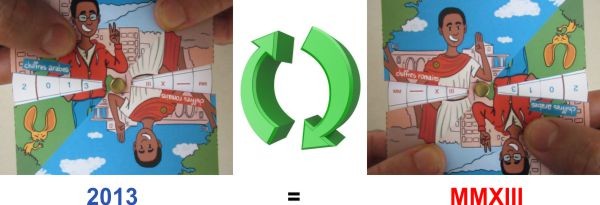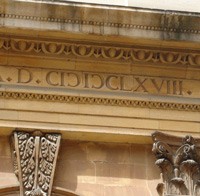 How to use - Roman/Arab numerals conversion disk
How to use - Roman/Arab numerals conversion disk
How to use the conversion disk :
Rotate the disks to compose a Roman numeral (in blue) or an Arabic numeral (in red).
Turn over the square to read the conversion.

To move the disc numbers, pass a finger behind the square and turn the thousands disk until the right number appears in the widow. Hold the disc with the thousands in the window with your thumb. Set the number for the hundreds. Hold the thousands and the hundreds with your thumb, and follow the same rule until your number is fully displayed in the window. 
This is a small video showing how to build the disc + a few examples of conversions.
Some information related to the video:
'You've traveled the bridge of Mont Blanc from one end to the other and have in front of you, at the centre of a small lawn, a monument showing two women supporting one another and looking in the direction of Switzerland. This monument symbolizes Geneva and Switzerland and was erected in 1869 in memory of the date when the canton of Geneva entered the Swiss Confederation (12th of September 1814).
In fact, Geneva had historically, and especially since the 15th century, very close links with the confederate cantons. This is shown by the treaties the city of Geneva concluded in 1477, 1526 and 1584 with Fribourg, Bern and Zurich (the 1519 treaty was cancelled by the Duke of Savoy).
Translated from ' Genève, guide historique ', Jean de Senarclens, Ed. le Tricorne, Geneva, 1995, 80 p.
Representation of the lack of zero in Roman numerals
Unlike Arabic numerals, Roman numerals have no zero.
We arbitrarily represented this lack of zero by a long horizontal line.

Various ways of writing Roman numerals
For our disk, we have tried to choose the most common ways to represent Roman numerals.
But there are several other methods and representations.
For example, there are 3 possibilities to write 4'000:
- MV (with a line above the V)
- IV (with a line above the two letters)
- MMMM (as on the disk)
Also sometimes found:
- IIII for 4 instead of IV (as on the disk)
- XXXX for 40 instead of XL (as on the disk)
- CCBC for 400 instead of CD (as on the disk)
For example, on watch dials the 4 is often represented by IIII instead of IV:

There are also other possible ways to write Roman numerals.
The 500, usually written D, can be sometimes written IƆ
The 1,000 usually written M, is sometimes written CIƆ
Below, an inscription on a theatre in Oxford, England. The building was erected in 1668: CIƆ = 1000 / / IƆ = 500 / / CLXVIII = 168

Wikipedia addresses the issue of the various ways of writing Roman numerals here: http://fr.wikipedia.org/wiki/Numération_romaine#Extensions
Advantages of Arabic numerals compared to Roman numerals
Today, we use Arabic numerals. They were invented in India but they reached us through the Arab world.
We abandoned the use of Roman numerals in everyday life because they had several disadvantages compaired to be Arabic numerals:
> The absence of zero causes two limitations:
- No result of calculation can equal zero
V-V =? (not possible with Roman numerals)
5 - 5 = 0 (possible with Arabic numerals)
- It is imppossible to write fractions
V: II =? (not possible with Roman numerals)
5: 2 = 2.5 (possible with Arabic numerals)
> Not easy to read:
A system with digits represented by letters and which must sometimes be substracted from others (IV = 4) is complex to read and can lead to many mistakes.
> Not suitable for calculations:
As it is very difficult to make calculations with Roman numerals, calculations were done in Roman times with a kind of abacus. Once the calculation with the abacus was made, the result was converted into Roman numerals. See: http://imrl.usu.edu/OSLO/technology_writing/001_003.htm
 |  |


